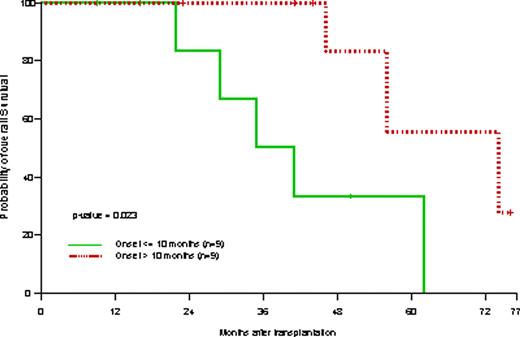Abstract
Abstract 1296
New monoclonal gammopathies (secondary MGUS) sometimes appear after autologous hematopoietic progenitor cell transplantation (AHPCT) for multiple myeloma (MM). While the pathophysiology and prognostic significance of this phenomenon is incompletely defined, previously published series hypothesize that this phenomenon is due to recapitulation of early B-cell ontogeny, and suggest that it confers a more favorable prognosis.[1-3] We retrospectively reviewed immunoelectrophoretic data on MM patients who underwent AHPCT at University Hospitals Case Medical Center from January 2000 - May 2009, searching for development of secondary MGUS after AHPCT. Secondary MGUS was defined as the occurrence of a monoclonal gammopathy of a different isotype (i.e. change in either the heavy chain, light chain, or both) than the patient's previously identified MM-associated monoclonal gammopathy at any time point after AHPCT.
We identified 89 MM patients who underwent AHPCT during that period. All patients received pre-transplant conditioning with melphalan 200 mg/m2 +/− TBI. Eighteen patients (20%) subsequently developed one or more secondary MGUS. There was no significant difference in age, gender, and stage of disease between patients who developed a secondary MGUS and those who did not (p=0.88). No patients who developed secondary MGUS had light-chain only disease at diagnosis. Nine patients developed a single new isotype, nine patients developed two or more new isotypes. The maximum number of new isotypes of monoclonal gammopathy in a single patient was six. Time to development of a secondary MGUS (latency) was highly variable, from 1.9 to 63.9 months, with a median of 10.5 months. One-third (33.3%) of patients who developed secondary MGUS developed their new isotype or isotypes more than a year after AHPCT. Amongst patients with secondary MGUS, the number of secondary isotypes was predictive of overall survival (OS). The hazard of death was 2.04 times higher with one increase of isotype (p = 0.016). There was a statistically significant association between latency to developing secondary MGUS and OS; for patients with latency ≤10 months, the median OS was 38 months, compared to 74 months for those with latency > 10 months (p = 0.023).
Secondary MGUS is a phenomenon observed in a substantial subset of patients undergoing AHPCT for MM. Our study demonstrates that this phenomenon cannot be entirely attributed to immune reconstitution, as previously postulated, as one-third of patients developed secondary MGUS a year or more after AHPCT. While selection bias may explain why patients who have longer latency to secondary MGUS have significantly better overall survival, further study is needed to clarify predictors of developing secondary MGUS and the pathophysiology underlying this phenomenon.
1. Maisnar, V., et al., Isotype class switching after transplantation in multiple myeloma. Neoplasma, 2007. 54(3): p.225-8.
2. Zent, C.S., et al., Oligoclonal protein bands and Ig isotype switching in multiple myeloma treated with high-dose therapy and hematopoietic cell transplantation. Blood, 1998. 91(9): p.3518-23.
3. Mitus, A.J., et al., Monoclonal and oligoclonal gammopathy after bone marrow transplantation. Blood, 1989. 74(8): p. 2764-8.
No relevant conflicts of interest to declare.
Author notes
Asterisk with author names denotes non-ASH members.


This feature is available to Subscribers Only
Sign In or Create an Account Close Modal